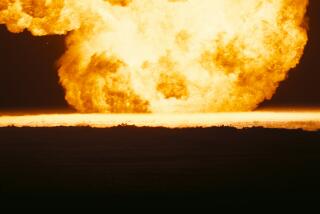Nuclear Fusion Claim Leaves Scientists Cold
- Share via
A claim by a team of engineers at Oak Ridge National Laboratory that they have achieved nuclear fusion inside tiny bubbles has been met with a wave of skepticism and criticism of the scientific journal that released the results Monday.
The team says it has created a form of nuclear fusion by zapping tiny bubbles of acetone with intense sound waves, causing the bubbles to expand massively and then implode. The imploding bubbles briefly created temperatures hotter than the surface of the sun, enough to cause hydrogen atoms to fuse together into atoms of helium, the researchers contend.
Nuclear fusion, the reaction that fuels the sun and the hydrogen bomb, releases massive amounts of energy. Harnessing that power--and creating it in a laboratory using cheap raw materials--is the goal of many engineers and physicists who say fusion might one day provide a clean and almost limitless source of energy.
Memories of ‘Cold Fusion’ Shape Response
But claims that scientists have achieved fusion labor under a cloud of suspicion. In 1989, two scientists at the University of Utah said they had found a way to extract energy from room-temperature water--cold fusion. Their claim was quickly disproved after a monthlong frenzy of news conferences, wild claims and sudden retractions. The episode is one Caltech physicist David Goodstein now calls “science gone berserk.”
The idea that energy can be extracted from bubbles is not controversial by itself. In the 1930s, German scientists discovered that bubbles pummeled by sound waves would implode and emit energy in the form of flashes of light. The phenomenon, called sonoluminescence, has intrigued physicists ever since; a full explanation of the phenomenon remains elusive.
Scientists at the University of Washington and at UCLA have extended the finding recently, pushing single bubbles to emit light with each pulse of sound and concentrating the amount of energy within tiny bubbles by trillions of times so they build up remarkably high pressures and temperatures.
“When the bubble is collapsing, the temperature at the surface is much hotter than the surface of the sun,” said Seth J. Putterman, a physicist at UCLA who has studied sonoluminescence for two decades. “Because the inside of the bubble can get even hotter, people have thought this could be an ideal candidate to see if there is fusion inside.”
But the notion that the energy involved could be enough to create fusion is controversial. The claim comes in a report to be published in the journal Science this Friday. The team, led by Rusi Pusi Taleyarkhan of the Oak Ridge, Tenn., lab, used a nuclear accelerator to hurl a stream of neutrons at a flask of acetone. Regular hydrogen atoms in the acetone had been replaced by deuterium atoms, which are easier to fuse than hydrogen.
The neutrons created bubbles about the size of the period at the end of this sentence. The sound waves caused the bubbles to expand hundreds of time in volume until they imploded into flashes of light and released their energy.
The scientists say they detected two signatures of fusion after the bubbles exploded: tritium, a radioactive element that is a product of deuterium fusion, and a type of neutron emissions typical of fusion reactions.
But experts in the field, including Putterman and top officials at the laboratory that conducted the work, have yet to be convinced.
The finding is so controversial that Lee Riedinger, Oak Ridge’s director for science and technology, asked two other scientists there to verify the experiment.
They could not. In a summary released Monday, nuclear physicists Dan Shapira and Mike Saltmarsh said they could not detect the emission of neutrons that would have come from a deuterium fusion reaction. The two used a larger detector and more sophisticated data analysis than the original team had employed. The neutrons detected in the original experiment, they suggest, may have come from background levels of neutrons, which are omnipresent and extremely difficult to remove from measurements.
The original authors remain undaunted. They say that Shapira and Saltmarsh overestimated the efficiency of their detectors and actually did detect the signature neutrons without realizing it.
Asked whether he believed the results were true and whether they were a breakthrough, Riedinger said he simply did not know.
“I feel we need another set of measurements,” Riedinger said.
Journal Is Accused of Overplaying Story
A number of physicists, even as they praised the idea and execution of the bubble experiment, said that it was premature for the article to be published and that the extraordinary claim requires more rigorous evidence.
“They’re claiming something very implausible. This would be a revolutionary, major discovery, a bridge between the mechanical and the nuclear,” said Larry Crum, a physicist at the Applied Physics Lab at the University of Washington. Crum was the first, along with his former student Felipe Gaitan, to create sonoluminescence in a single bubble.
Many physicists, including Robert Park of the University of Maryland, took issue with how the article was treated by the editors of Science. The article was chosen for publication, used as the cover article and accompanied by news releases and “a lot of hoopla,” Park said, even though several distinguished physicists, including Crum, advised against publication without additional improvements to the experiment.
“The reason for concern are the parallels between this and the cold-fusion episode 13 years ago,” said Park, a legendary debunker of bad science and the author of a book titled “Voodoo Science.”






